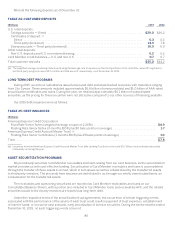American Express 2015 Annual Report Download - page 101
Download and view the complete annual report
Please find page 101 of the 2015 American Express annual report below. You can navigate through the pages in the report by either clicking on the pages listed below, or by using the keyword search tool below to find specific information within the annual report.
CRITICAL ACCOUNTING ESTIMATES
Refer to Note 1 to the “Consolidated Financial Statements” for a summary of our significant accounting policies.
Certain of our accounting policies requiring significant management assumptions and judgments are as follows:
RESERVES FOR CARD MEMBER LOSSES
Reserves for Card Member losses represent our best estimate of the probable losses inherent in our outstanding
portfolio of Card Member receivables and loans, as of the balance sheet date. As of December 31, 2015, this estimate does
not reflect Card Member loans and receivables HFS. Refer to Note 2 to the “Consolidated Financial Statements” for
additional information.
In estimating these losses, we use statistical and analytical models that analyze portfolio performance and reflect our
judgment regarding the quantitative components of the reserve. The models take into account several factors, including
delinquency-based loss migration rates, loss emergence periods and average losses over an appropriate historical period,
as well as expected future recoveries. We also consider whether to adjust the quantitative reserve for certain external and
internal qualitative factors that may increase or decrease the reserves for losses on Card Member receivables and loans.
The process of estimating these reserves requires a high degree of judgment. To the extent historical credit
experience, updated for any external and internal qualitative factors such as environmental trends, is not indicative of
future performance, actual losses could differ significantly from our judgments and expectations, resulting in either higher
or lower future provisions for Card Member losses in any quarter.
As of December 31, 2015, a 10 percent increase in our estimate of losses inherent in the outstanding portfolio of Card
Member receivables and loans evaluated collectively for impairment, would increase reserves for losses with a
corresponding change to provisions for losses by approximately $149 million. This sensitivity analysis is provided as a
hypothetical scenario to assess the sensitivity of the provisions for losses. It does not represent our expectations for
losses in the future, nor does it include how other portfolio factors such as delinquency-based loss migration rates or
recoveries, or the amount of outstanding balances, may impact the level of reserves for losses and the corresponding
impact on the provisions for losses.
LIABILITY FOR MEMBERSHIP REWARDS EXPENSE
The Membership Rewards program is our largest card-based rewards program. Card Members can earn points for
purchases charged on their enrolled card products. Certain types of purchases allow Card Members to also earn bonus
points. Membership Rewards points are redeemable for a broad variety of rewards including travel, entertainment, retail
certificates and merchandise. Points typically do not expire, and there is no limit on the number of points a Card Member
may earn.
We record a Membership Rewards liability that represents the estimated cost of points earned that are expected to be
redeemed by Card Members in the future. The Membership Rewards liability is impacted over time by enrollment levels,
attrition, the volume of points earned and redeemed, and the associated redemption costs. We estimate the Membership
Rewards liability by determining the URR and the WAC per point, which are applied to the points of current enrollees.
The URR assumption is used to estimate the number of points earned by current enrollees that will ultimately be
redeemed in future periods. We use statistical and actuarial models to estimate the URR of points earned to date by
current Card Members based on redemption trends, card product type, enrollment tenure, card spend levels and credit
attributes. The WAC per point assumption is used to estimate future redemption costs and is primarily based on
redemption choices made by Card Members, reward offerings by partners, and Membership Rewards program changes.
The WAC per point is derived from the previous 12 months of redemptions and is adjusted as appropriate for certain
changes in redemption costs that are not representative of future cost expectations.
We periodically evaluate our liability estimation process and assumptions based on developments in redemption
patterns, cost per point redeemed, partner contract changes and other factors. The process of estimating the
Membership Rewards liability includes a high degree of judgment. Actual redemptions and associated redemption costs
could differ significantly from our judgment, resulting in either higher or lower Membership Rewards expense.
Changes in the Membership Rewards URR and WAC per point have the effect of either increasing or decreasing the
liability through the current period marketing, promotion, rewards and Card Member services expense by an amount
estimated to cover the cost of all points previously earned but not yet redeemed by current enrollees as of the end of the
reporting period. As of December 31, 2015, an increase in the estimated URR of current enrollees of 100 basis points
would increase the Membership Rewards liability and corresponding rewards expense by approximately $341 million.
Similarly, an increase in the WAC per point of 1 basis point would increase the Membership Rewards liability and
corresponding rewards expense by approximately $85 million.
90
























